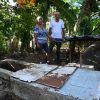Monday, April 29, 2024
News and Views from the Global South
Population
A Key Role for 1.8 Billion Youth in UN’s 2030 Development Agenda

Students in Primary Seven at Zanaki Primary School in Dar es Salaam, Tanzania during an English language class. Credit: Sarah Farhat/World Bank.
- The UN Population Fund (UNFPA) is convinced that the world’s 1.8 billion adolescents and youth– a quarter of the global population—have a key role to play in helping implement the UN’s 2030 Development Agenda.
In an interview with IPS, UNFPA Deputy Executive Director (Programme) Dereje Wordofa, said “young people are at the centre of sustainable development”.
“If we do not work with, and for them, there is no way we can achieve the sustainable development goals by 2030, or UNFPA’s three transformative results,” he warned.
Through “My Body, My Life, My World!”, UNFPA is also contributing to each of the five priorities of the UN’s overall Youth Strategy, “Youth 2030”.
Dereje Wordofa, UNFPA Deputy Executive Director (Programme)
Speaking during International Youth Day on August 11, UN Secretary-General Antonio Guterres complained schools are “not equipping young people with the skills they need to navigate the technological revolution.”
Last year, he also stressed the importance of young people in addressing the challenges confronting the contemporary world, including peace, impacts of climate change and growing inequalities.
“The best hope [to address these] challenges is with the new generations. We need to make sure that we are able to strongly invest in those new generations,” said Guterres, urging the international community to be fully engaged in addressing a key problem of youth unemployment.
Asked how realistic was UNFPA’s strategy in poverty-stricken communities struggling to survive on less than $1.25 a day, Wordofa told IPS: “Having lived and worked in many countries affected by poverty and deprivation, including in my own Ethiopia, I couldn’t agree with you more”
He said Sustainable Development Goal 1 (SDG 1) is a lynchpin for all the other SDGs, and in all sectors of development “we are contributing towards reducing poverty. I believe empowered young people will play a vital role here too”.
“At UNFPA, we firmly believe that one of the most essential routes to achieving sustainable development lies in educating and empowering young people to make decisions about their health and wellbeing, giving them the tools to take charge of their lives, to drive development, and to sustain peace”.
“We must recognize that adolescents and young people make up the majority of the population in many economically poor nations,” he declared.
“ If we make coherent, tailored, large-scale reforms and investments, especially in health (including sexual and reproductive health), skills development, and employment, those nations can achieve a huge demographic dividend from their healthy, empowered young populations,’ said Wordofa, who earlier served as the International Regional Director, Eastern and Southern Africa, at SOS Children’s Villages and Regional Director for Africa at the American Friends Service Committee.
In this context, he pointed out that UNFPA’s “My Body, My Life, My World!” is a human-centric approach: “we are emphasizing how all the different issues affecting adolescents and youth today are interlinked and inseparable”.
“For example, without rights and choices over their bodies, it is not possible for young people to have full control over their lives and actively shape their communities and end poverty. So we must continue to address the complex determinants that affect young people’s health and wellbeing,” he noted.

UNFPA Deputy Executive Director (Programme) Dereje Wordofa.
Excerpts from the interview:
IPS: How best would you describe the UNFPA’s new strategy on adolescents and youth?
WORDOFA: UNFPA’s vision is to create a world where every young person can make their own choices and enjoy their rights. The strategy titled “My body, my life, my world!” is our new rallying cry for every young person to have the knowledge and power to make informed choices about their bodies and lives, and to participate in transforming their world.
The strategy puts young people – their talents, hopes, perspectives and unique needs – at the very centre of sustainable development, and offers a new approach to collaborate with, invest in, and champion young people around the world. It encompasses everything that was called for and promised by world leaders at the International Conference on Population and Development (ICPD) back in 1994 in Cairo.
“My Body, My Life, My World!” provides a new narrative for all of UNFPA’s youth work, building on the organization’s strategic plan and the UN’s “Youth 2030” strategy, and putting young people’s sexual and reproductive health and rights at the core of what we do both in development and humanitarian settings.
In addition to the crucial need for young people to enjoy their right to sexual and reproductive health, the strategy also includes their fundamental right to participate in sustainable development, humanitarian action and sustaining peace.
By working with and for young people, we will deliver across the three spheres that matter to them – their body, life, and world. This will be essential if we are to finally fulfil the promise of the ICPD of rights and choices for all adolescents and youth.
IPS: Are you working on a deadline for its implementation?
WORDOFA: UNFPA seeks to achieve its three transformative goals by 2030; namely zero unmet need for family planning, zero maternal deaths and zero violence and harmful practices against women and girls. “My Body, My Life, My World!” will be a key accelerator to achieving these three goals.
IPS: Do you think the world’s 1.8 billion adolescents and youth now remain largely marginalized in decisions relating to reproductive health, marriage and child-bearing?
WORDOFA: Yes! It is a sad fact that far too many young people are still a long way from being able to exercise their reproductive rights, despite being promised them by world leaders twenty-five years ago at the International Conference on Population and Development in Cairo.
The numbers are staggering: 21 per cent of girls worldwide are married before age 18. Tens of thousands of girls get married every day. And every day in developing countries, 20,000 girls under age 18 give birth: this amounts to 7.3 million births a year.
The choices young people make—or are forced to make—determine their lives now, their futures as adults, and the health of future generations. A single choice, for example, to stay in school may protect against early pregnancy, child marriage, gender-based violence and HIV infection.
Yet many young people will not be able to make that choice. Poverty, humanitarian crises, race, ethnicity, gender and cultural traditions are just some of the barriers that may stand in the way.
IPS: What role can civil society play in promoting the Youth strategy in the developing world?
WORDOFA: Making a real difference in the lives of young people rests on shared leadership and shared responsibility. Youth-led and youth-serving organizations, governments, community leaders, UN entities, civil society, academia, the private sector and the media all have essential roles to play.
As UNFPA, we take pride in being a trusted ally and partner for youth leaders, organizations and networks. We systematically invest in strengthening national and regional youth-led networks, and pioneering models for youth leadership and participation in many countries.
Adolescents and youth both benefit from our programmes, and as our close partners, offer vital contributions to shaping their design and implementation.
For “My Body, My Life, My World!” we are excited to strengthen and broaden our partnership base and collaborate with youth-led organizations, community-based organizations, but also iNGOs, to scale up joint implementation efforts with young people.
IPS: How will your young professional network – the Tangerines – described as the first of its kind in the UN system, be deployed in promoting your new strategy?
WORDOFA: The Tangerines played an important role in formulating and shaping the strategy. We will continue to provide a safe space and promote an organizational culture that encourages young professionals within UNFPA to be closely linked to the implementation of “My Body, My Life, My World!” We know we need to start by walking the talk.
At the conception phase of the Strategy, we conducted a global survey with Tangerine members and consulted with our Executive Director, Dr Natalia Kanem, and the UN Secretary General’s Youth Envoy to explore how UNFPA was delivering for young people and what could be strengthened.
We are planning to collaborate closely with the Tangerines for the global launch and promotion of the Strategy, as well as when thinking about how we can reach young people and operationalize the strategy.
The writer can be contacted at thalifdeen@ips.org

 Print
Print



